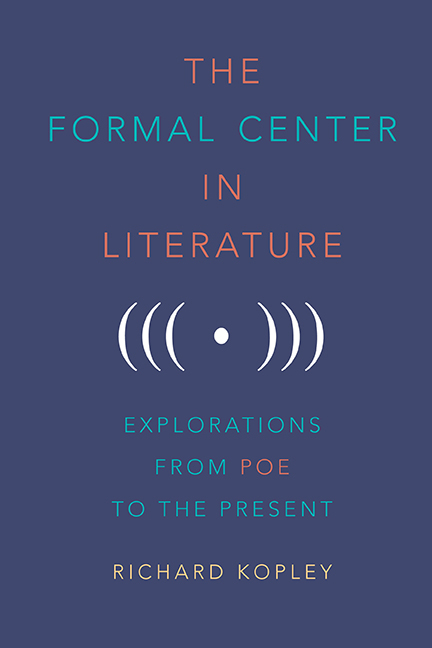Book contents
- Frontmatter
- Dedication
- Contents
- Acknowledgments
- Introduction
- 1 “Mournful and Never-Ending Remembrance” in Edgar Allan Poe's The Narrative of Arthur Gordon Pym
- 2 Retracing Our Steps in Edgar Allan Poe's “The Man of the Crowd”
- 3 “Scrutinizing the Parchment More Closely”: The Form of “The Gold-Bug” and Its Relationship to That of the Dupin Tales
- 4 Form and Reform in Nathaniel Hawthorne's “Earth's Holocaust”
- 5 The Circle and Its Center in Herman Melville's “Bartleby, the Scrivener”
- 6 Chiasmus in Henry David Thoreau's Walden
- 7 The Mythological Centers of Lewis Carroll's Alice Books
- 8 Table as Text in James Joyce's “The Dead”
- 9 The Structure of Sherwood Anderson's “Hands”
- 10 The Architecture of Ernest Hemingway's “The Three-Day Blow”
- 11 Balance in Dashiell Hammett's The Maltese Falcon
- 12 Framing Caesar in Raymond Chandler's The Big Sleep
- 13 The Ridge of the Domino in Patricia Highsmith's Strangers on a Train
- 14 The “X in the Air” in Joyce Carol Oates's “Where Are You Going, Where Have You Been?”
- 15 The Hybrid Center of Zadie Smith's White Teeth
- Notes
- Bibliography
- Index
11 - Balance in Dashiell Hammett's The Maltese Falcon
Published online by Cambridge University Press: 14 June 2019
- Frontmatter
- Dedication
- Contents
- Acknowledgments
- Introduction
- 1 “Mournful and Never-Ending Remembrance” in Edgar Allan Poe's The Narrative of Arthur Gordon Pym
- 2 Retracing Our Steps in Edgar Allan Poe's “The Man of the Crowd”
- 3 “Scrutinizing the Parchment More Closely”: The Form of “The Gold-Bug” and Its Relationship to That of the Dupin Tales
- 4 Form and Reform in Nathaniel Hawthorne's “Earth's Holocaust”
- 5 The Circle and Its Center in Herman Melville's “Bartleby, the Scrivener”
- 6 Chiasmus in Henry David Thoreau's Walden
- 7 The Mythological Centers of Lewis Carroll's Alice Books
- 8 Table as Text in James Joyce's “The Dead”
- 9 The Structure of Sherwood Anderson's “Hands”
- 10 The Architecture of Ernest Hemingway's “The Three-Day Blow”
- 11 Balance in Dashiell Hammett's The Maltese Falcon
- 12 Framing Caesar in Raymond Chandler's The Big Sleep
- 13 The Ridge of the Domino in Patricia Highsmith's Strangers on a Train
- 14 The “X in the Air” in Joyce Carol Oates's “Where Are You Going, Where Have You Been?”
- 15 The Hybrid Center of Zadie Smith's White Teeth
- Notes
- Bibliography
- Index
Summary
HAVING WORKED FOR Pinkerton's National Detective Service for six years (1915–21) and then written detective fiction for Black Mask for another six (1922–28)—leading to Red Harvest (1929) and The Dain Curse (1929)—Dashiell Hammett was well prepared to write the five serial installments that became the 1930 novel The Maltese Falcon. If, as Dorothy Parker wrote in 1931, “there is entirely too little screaming about the work of Dashiell Hammett,” the screaming certainly grew, and Christopher Metress could rightly state in 2005 that The Maltese Falcon is “now counted among the masterpieces of American literature.”
Yet there remains a question about the nature of its structure. We may seem forewarned: Hammett wrote in 1934 at the beginning of his introduction to the Modern Library Edition of the novel, “If this book had been written with the help of an outline or notes or even a clearly defined plot-idea in my head I might now be able to say how it came to be written and why it took the shape it did.” James Guetti later contended, regarding the novel, that “Everything is strange in this story because everything is laid out in pieces.” William Marling responded to Guetti that the difficulty with reading The Maltese Falcon is that we have lost its context, “the mediation by the Victorian of the modern.” He adds, “There is no way to press the novel, as Guetti implies, and wrest the ‘mystery’ from its resisting details.” I do not wish to “press the novel,” but I do believe that the novel may press us. Without outline, notes, or plot-idea, Hammett nonetheless created what Richard Layman rightly termed “a unified novel.” This critic declared, “It is written with a mature sense of dramatic structure” —and, I would add, it is written with a keen sense of verbal structure, as well. Symmetry need not be wholly planned out; it may develop organically. That the pieces of The Maltese Falcon form a distinct whole becomes clearer if we investigate the novel with attention to roughly symmetrical language framing a significant center. The symmetry and the center will become evident, and they help reveal Hammett's abiding concern in The Maltese Falcon with balance.
- Type
- Chapter
- Information
- The Formal Center in LiteratureExplorations from Poe to the Present, pp. 92 - 98Publisher: Boydell & BrewerPrint publication year: 2018



